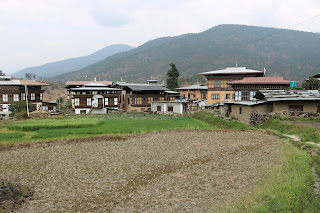March 17, 2018
We packed up and left the capital city of Thimphu today to make our way to Punakha. Traveling a curvy mountainous road we made our way up to the Dochula Pass. At 10,000 feet I could begin to really experience being in the Himalayas. There was no snow and you could see signs that spring was arriving with trees and flowers blooming.
At Dochula Pass is the Druk Wangyal Chortens. A collection of 108 chortens (stupas) built by the Queen Mother as a memorial in honor of the Bhutanese soldiers who were killed in the battle led by her husband against insurgents from India in the southern part of the country.
We packed up and left the capital city of Thimphu today to make our way to Punakha. Traveling a curvy mountainous road we made our way up to the Dochula Pass. At 10,000 feet I could begin to really experience being in the Himalayas. There was no snow and you could see signs that spring was arriving with trees and flowers blooming.
At Dochula Pass is the Druk Wangyal Chortens. A collection of 108 chortens (stupas) built by the Queen Mother as a memorial in honor of the Bhutanese soldiers who were killed in the battle led by her husband against insurgents from India in the southern part of the country.
There is also a monastery located at the Pass.
The mountain road goes through the Royal Botanical Park. There are beautiful views of the mountains and valleys.
We stopped at this roadside farmers market. They had a wide variety of fresh produce.
Pema bought a bag of rice puffs for us to try. They
were very light and airy with not a lot of flavor.
A farmer shelling peas
We continued to descend down the mountains to the Punakha Valley. It is a subtropical area that used to serve as the capital until 1955 when it was moved to Thimphu.
The villages were surrounded by the rice fields. With the mild temperatures year round they are able to grow 2 crops each year.
Sang Old McDonald song with these kids. They were having fun.
Amanda taking their pictures.
After lunch we walked along a narrow path winding through the rice fields to the village of Sopsokha.
A water driven prayer wheel.
The houses where decorated with some graphic designs. I am not going to post some as they might be offensive to some of my readers. If you want to research what I’m referring to look up the Divine Madman of Bhutan (but be warned it relates to male genitalia).
Workers making mud bricks and placing them out to dry.
Pema showing us his Ninja look.
A new house under construction.
Up on the top of the hill sits the Chimi Lhakhang monastery that was built in 1499. It is known as the fertility temple as couples come here for a blessing by the monks and is related to the Madman I mentioned above.
I told you that I would explain the prayer flag colors so here it is.
The flags, made in five colors representing the natural forces, — "blue (sky), white (clouds), red (fire), green (water) and yellow (earth)" – are inscribed with Buddhist scriptural prayers to usher prosperity and peace around the country.
A prayer wheel.
If you want to learn more about the Divine Madman then enlarge this sign and read but again be forewarned.
The temple.
The monks were having a ceremony inside. As we entered one of the monks tapped us on the head and gave us a blessing (NO, it wasn’t a fertility blessing. At least I hope not!)
Some village children playing in the rice fields.
When we returned to the village, we visited a farm family to learn about their lifestyle and the type of home they lived in. Mrs. Dago Zam served us tea and a tasting of an alcoholic drink they distilled themselves. She was very gracious and hospitable.
Baskets and storage containers in the hallway. We climbed up to the second floor to see the bedroom.
Her husband showed us the prayer and alter room. They had only been married for 5 months. As is traditional he moved into her home with her parents.
Drums that are played by the monks during special ceremonies.
Tenpin, our driver, standing outside the home.
They have a fairly modern kitchen with a gas burner stove and a new microwave.
She was cooking a meal and showed us one of the dishes she was preparing.
A group picture with her father.
The outside of the house.
We left the village and went to our hotel. It was nice to see some flowering plants.
Tomorrow we will tour the surrounding area.



















































No comments:
Post a Comment